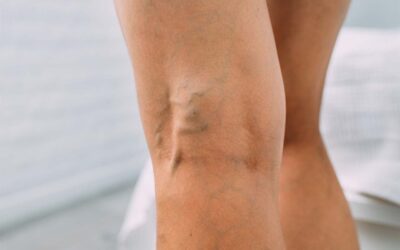The word “cankle” became widespread in pop culture when Jason Alexander’s character in the movie Shallow Hal used the term to describe an overweight women’s lower leg. For some women, developing thick ankles is no laughing matter it could actually reveal an undiagnosed health issue and have very little to do with diet and exercise.
If your ankles are swollen, overlarge, or seem to merge with your calves rather than being clearly defined, you may have ‘cankles’. This term describes the appearance the lower leg has when there is excess fatty tissue below the knee. To help the public understand the causes and treatment of this common condition, Dr Peter Paraskevas, a leading phlebologist and cosmetic surgeon has developed a guide to explain the medical conditions that may cause cankles and the best way to treat them.
What medical conditions can cause swelling of the ankles?
Venous disease/insufficiency
When your veins have trouble sending blood from your limbs back to the heart, it’s known as venous insufficiency. In this condition, blood doesn’t flow back properly to the heart, causing blood to pool in the veins in your legs. Several factors can cause venous insufficiency, though it’s most commonly caused by deep vein thrombosis, (blood clot) or varicose veins.
Symptoms of venous insufficiency can include:
- Swelling of the legs or ankles
- Painful, throbbing and heavy legs
- Thickening of the skin on the legs and ankles
- Skin that changes colour around the ankles
Pregnancy
Varicose veins that appear during pregnancy can cause discomfort, cramps and swelling, especially around the ankles. Pregnancy can aggravate pre-existing varicose veins, or many women who have pregnancy-related veins may have never ever noticed veins before.
Pelvic varicose veins can develop during pregnancy which put pressure on veins in the thighs and lower legs and can lead to severe swelling in the ankles, causing extreme pain and discomfort.
Lymphoedema
Excess build-up of fluid in the lower legs is referred to as lymphoedema.
Primary lymphoedema can occur in childhood, (congenital onset lymphoedema), in adolescence (lymphoedema praecox) or later in life (lymphoedema tarda), with no identifiable cause; Secondary lymphoedema can occur secondary to heart/liver/kidney failure, malnourishment (albumin deficiency), blood clots or blockages in the lymphatic system, varicose vein disease, and other medical issues.
This form of fluid retention requires careful assessment and appropriate management.
Lipoedema
Lipoedema is a chronic progressive medical disease that causes disproportionate swollen fat deposition in the arms and legs. It tends to be passed down genetically and around 10-15% of women will be affected at some point in their lives. Individuals with lipoedema have a marked discrepancy between their slim upper body and symmetrically enlarged lower body. It is difficult to resolve lipoedema with exercise and dieting alone. There may be a slight reduction in the amount of fat, but the thighs and/or legs will always appear disproportionate to the rest of the body. Varicose vein disease is often present in conjunction with lipoedema and associated mild lymphoedema.
What treatments are available?
Whether your ‘cankles’ are caused by an undiagnosed health issue or another condition, you deserve to get an effective treatment. As a starting point, see your GP to account for any of the medical causes of ankle swelling.
Conservative treatment should be considered as a method of controlling symptoms and swelling. Manual Lymphatic Drainage (usually provided by a Lymphatic Nurse) can help alleviate swelling in the legs along with wearing graduated compression stockings.
These temporary measures may treat the swelling and discomfort, but do not actually treat the fatty accumulation in the legs. This is where liposculpture can be offered as a more sustained and permanent solution.
Says, Dr Paraskevas of Paras Clinic “With liposculpture, we basically inject the fat with anaesthetic solution to help disperse it, and then gently suction the fat through a small microcannula. Once the fat is removed, it will not come back. Liposculpture not only improves the physical appearance of cankles by returning some balance to the body’s proportion but improves any symptoms the patient may have been experiencing.
Tumescent Based Liposculpture is the Gold Standard for removing cankles permanently. It is best performed under local anaesthesia with very mild sedation and pain relief for better results, faster recovery and less pain.
Dr Paraskevas says the main benefits of laser-assisted liposculpture for treating cankles includes:
- Removing the damaged inflammatory fat to preserve lymphatic health and circulation of the legs.
- It alleviates discomfort and swelling.
- Avoids the long-term dependence on compression garments and manual lymphatic drainage which can be costly and time consuming.
- Long-term, there is less chance of scar-like tissue called fibrosis, forming.
- It will preserve mobility and reduce degenerative conditions such as arthritis on the hips, knees and ankles.
- The appearance of the limbs will be in proportion with the rest of the body, relieving any psychological burdens from the patient.
“It is highly recommended patients that undertake this procedure maintain their weight with a healthy diet and exercise. Procedures like liposuction have become increasingly popular in the past 10 years. I urge potential patients to do their research,” says Dr Paraskevas.
For more information on this new technology for treating ‘cankles’ visit sculptureclinic.com.au/cankles-lipoedema-liposuction, part of the Paras Clinic group.






